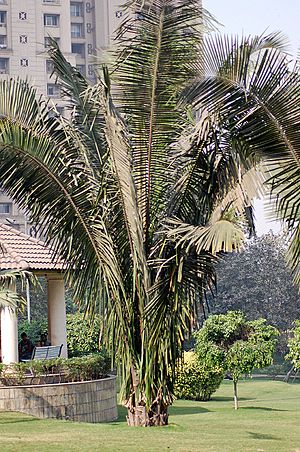Cohune palm facts for kids
Quick facts for kids Cohune palm |
|
|---|---|
 |
|
| A Cohune palm tree | |
| Scientific classification | |
| Genus: |
Attalea
|
| Species: |
cohune
|
The cohune palm (scientific name: Attalea cohune) is a tall palm tree found in Mexico and parts of Central America. It is also known by other names like rain tree, American oil palm, corozo palm, or manaca palm.
This amazing tree is important because its nuts can be used to make cohune oil. The hard nuts can also be used as a natural material called vegetable ivory.
Contents
What is the Cohune Palm?
The cohune palm is a type of palm tree. It can grow very tall, sometimes up to 18 meters (about 60 feet) high! It has a thick trunk and large, feathery leaves that can be up to 10 meters (33 feet) long.
The tree produces many large, oval-shaped nuts that grow in big bunches. These nuts are very hard and contain a valuable oil.
Where Does the Cohune Palm Grow?
The cohune palm is native to warm, tropical areas. You can find it growing naturally in southern Mexico and many countries in Central America. These include Belize, Guatemala, Honduras, and El Salvador.
It often grows in forests and can be a very common tree in certain areas. For example, it is a main plant found in the Belizean pine forests. This means it's one of the most important and widespread trees in those areas.
How is the Cohune Palm Used?
The cohune palm has been used by people for a long time. Its nuts are especially useful.
Cohune Oil
The nuts of the cohune palm are pressed to make cohune oil. This oil is similar to coconut oil. It can be used for cooking, making soap, and in cosmetics like lotions and creams. It's a natural and useful product from the tree.
Vegetable Ivory
The hard shell of the cohune nut is so strong that it can be used as vegetable ivory. This material looks a bit like real ivory, which comes from elephant tusks. Because it's natural and doesn't harm animals, vegetable ivory is a great choice for making things like buttons, small carvings, and jewelry.
Images for kids
See also
 In Spanish: Attalea cohune para niños
In Spanish: Attalea cohune para niños


